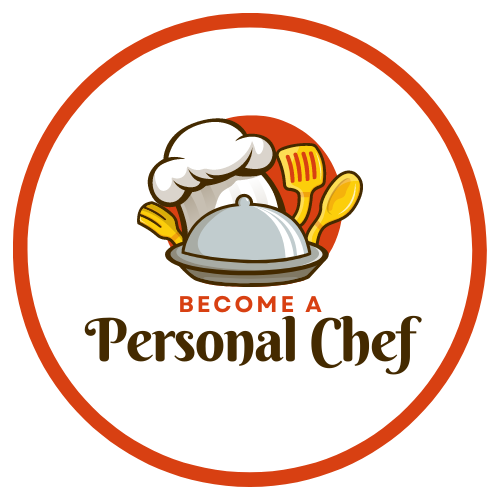Table of Contents
ToggleAdd a Personal Touch
In the food industry, a “personal touch” is often what sets apart one chef from another. It’s the unique style, flavor, or presentation that makes your dishes distinctly yours.
This personal touch not only adds a level of creativity and originality to your cooking but also creates a memorable dining experience for your clients. Here’s how you can add your own unique personal touch to your services as a new personal chef.
Curious about the blueprint for running a successful personal chef company? Dive right in! Click here to unlock an exciting journey where we unravel the fundamental steps and elaborate strategies that you need to conquer for a rewarding career as a personal chef. Don’t wait, your success story starts here!

Promoting Your Unique Style
Signature Dish Names
One of the easiest ways to add a personal touch to your cooking is by labeling your dishes with signature names. These could be inspired by the story behind the dish, the ingredients used, or even a personal anecdote. A uniquely named dish piques the interest of the diner and adds an element of surprise to the dining experience.
Here are some ideas for signature dish names that you can use to elevate your cooking game.
1. Grandma’s Secret Meatloaf
This classic comfort food takes on a whole new level of nostalgia when labeled with the name “Grandma’s Secret Meatloaf.” Not only does it pay tribute to your grandmother’s cooking, but it also adds an air of mystery and exclusivity to the dish. You could even add a note on the menu explaining how this recipe has been passed down for generations, making it even more special.
2. Farmer’s Market Frittata
If you’re using fresh ingredients from your local farmer’s market, why not showcase them in the name of your dish? A simple frittata becomes much more appealing when titled “Farmer’s Market Frittata,” as it implies freshness and quality. Plus, customers will appreciate knowing where their food is coming from.
3. Savory Herb-Crusted Salmon
This dish not only sounds delicious but also has a sophisticated feel to it. By using the words “savory” and “crusted,” you’re already painting a picture of a flavorful, crispy salmon that will make people’s mouths water. And by specifying that the crust is made of herbs, you’re adding another layer of complexity to the dish.
Aspiring personal chefs need to offer something different than traditional chefs who specialize in one or two kinds of cuisines. I’ve written an extensive article with links to many cuisines for your consideration – World Cuisine for Personal Chefs
Personalized Menu Planning
Another way to add a personal touch is through personalized menu planning. This involves tailoring your menu to fit the preferences, dietary requirements, and the occasion at hand for each client. This shows consideration and attention to detail, enhancing customer satisfaction and loyalty.
With personalized menu planning, you can take into account any food allergies or intolerances that your client may have. This ensures that they can fully enjoy their meal without any worries. You can also incorporate their favorite foods and flavors, creating a truly unique dining experience for them.
Personalized menu planning allows you to cater to different types of events or occasions. If it’s a romantic dinner for two, you might include aphrodisiac ingredients or create a special tasting menu.
If it’s a family gathering, you might focus on family-style dishes or kid-friendly options. By understanding the purpose of the event and the guests’ preferences, you can design a menu that not only satisfies taste buds but also enhances the overall experience.
Incorporating Rare Ingredients or Cultural Cuisine
Incorporating rare ingredients or elements of your cultural cuisine into your dishes is another great way to make your mark. This not only adds a unique flavor profile to your dishes, but also gives your clients a taste of something new and exciting.
Whether it’s a specific spice blend from your home country or an exotic fruit that is not commonly found in their local grocery store, incorporating these ingredients will set you apart from other personal chefs.
Incorporating cultural cuisine into your dishes also allows you to share a piece of your heritage with others. It can spark interesting conversations with clients and create a more personal connection between you and them.
Don’t be afraid to add a twist on traditional dishes or combine different cultural flavors to create a fusion dish. This is your opportunity to get creative and showcase your unique culinary skills.

Dealing with Imposter Syndrome
As a new personal chef, you might sometimes feel like you’re not good enough or that you’re a fraud. This is known as imposter syndrome. It’s a common feeling among professionals, but it can be particularly challenging for personal chefs who are often working alone and may not have the same level of validation as those in traditional office jobs.
Here’s how you can deal with it:
Seek Guidance from Established Chefs
Established chefs have been in your shoes before and can offer valuable advice and support. Don’t hesitate to reach out to them for guidance or mentorship. They may be able to provide insights on how to improve your skills, navigate the competitive industry, and offer helpful tips on running a successful personal chef business.
Attend Culinary Workshops and Conferences
One of the best ways to improve your culinary skills is by attending workshops and conferences. These events offer hands-on training, cooking demonstrations from renowned chefs, and networking opportunities with other professionals in the industry. You’ll also have the chance to learn about new techniques, ingredients, and trends in the world of food.

Continuous Learning
The culinary world is vast and constantly evolving. Always be open to learning new techniques, trying out new ingredients, and experimenting with different cuisines. As a personal chef, continuous learning is key to staying ahead in the industry and providing top-notch service to your clients.
As you gain experience and refine your skills, it’s important to continue seeking out opportunities for growth and development. This can include attending cooking classes or workshops, reading cookbooks and food blogs, networking with other chefs, and even traveling to different countries to learn about their cuisines.
By continuously learning, you not only expand your knowledge and repertoire as a chef, but also keep your creativity flowing. You may discover new flavor combinations or techniques that will elevate your dishes and impress your clients.
Practice New Dishes
The more you practice, the better you become. Regularly try out new recipes and techniques to improve your skills and boost your confidence. Don’t be afraid to step out of your comfort zone and experiment with different flavors and cuisines.
Learning from Mistakes
Mistakes are a natural part of the learning process. Don’t get discouraged if your dish doesn’t turn out perfectly on the first try. Use it as an opportunity to learn and improve. Take note of what went wrong and adjust accordingly for future attempts.

When Should You Start Implementing Your Personal Touch?
From day one! Your personal touch is what sets you apart from other chefs. However, it’s important to balance your unique style with the preferences and expectations of your clients. As you gain experience and expertise, you’ll become better at striking this balance. Here are a few tips for incorporating your personal touch into your services:
1. Get to know your clients: Before you even start cooking for a client, take the time to get to know them. Ask about their food preferences, dietary restrictions, and any special occasions or events that may be coming up. This will help you tailor your services specifically to their needs and desires.
2. Offer personalized menu options: Instead of having a set menu, offer customizable options based on each client’s preferences. This not only shows that you value their input but also allows you to showcase your creativity by creating unique dishes for each individual.
3. Use quality ingredients: Your personal touch can also come through in the ingredients you use. Choose local, organic, and sustainable options whenever possible. Not only does this support local businesses and farmers, but it also showcases your commitment to providing healthy and environmentally-friendly meals.
4. Keep up with current food trends: Stay informed about current food trends and incorporate them into your menu. This can include using superfoods, incorporating plant-based options, or offering gluten-free or paleo alternatives. By staying on top of trends, you show that you are a knowledgeable and versatile personal chef.
5. Communicate clearly: Effective communication is key in any client relationship. Be sure to communicate clearly and promptly with your clients about menus, scheduling, and any changes or updates. This will ensure that there are no misunderstandings or surprises along the way.
Wondering what tools a personal chef might need? I’ve written an extensive article for you – A Comprehensive List Of Must-Have Tools and Essential Items for the Personal Chef
A Personal Chef’s Personal Touch
A personal touch is a powerful tool in the food industry. It adds value to your services, enhances the dining experience, and can help you stand out in the market.
So, start experimenting with your unique style, learn continuously, and remember to have fun in the process!

